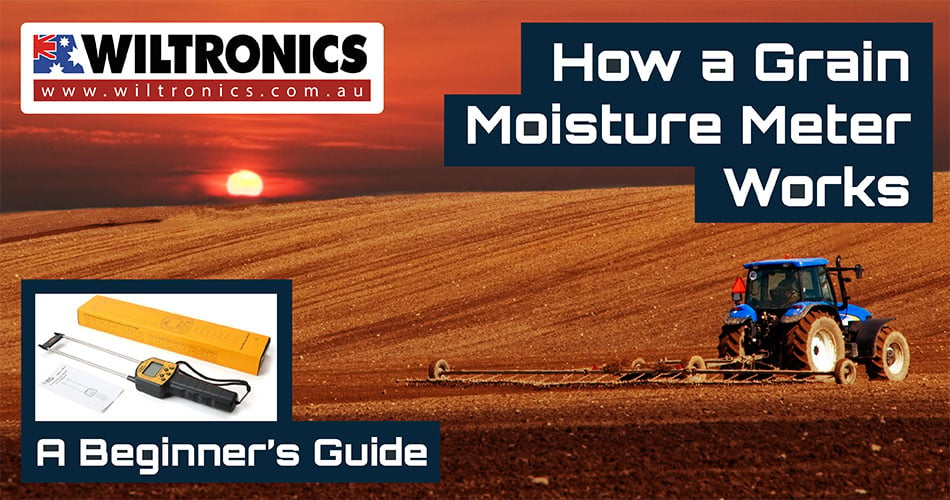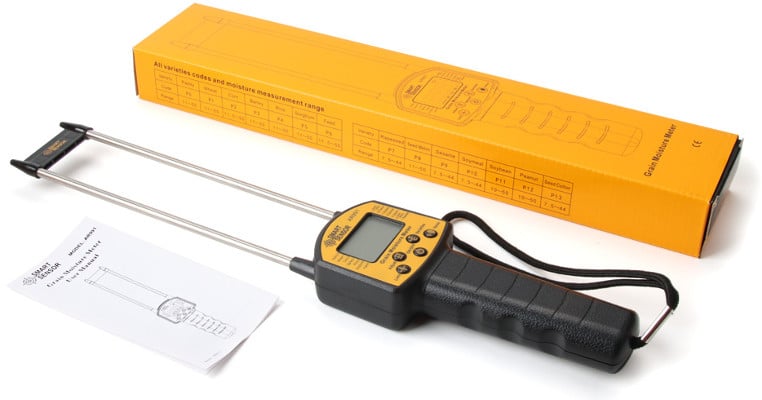How a Grain Moisture Meter Works: A Beginner’s Guide
March 11, 2022

Thanks to the very existence of calibrators and all kinds of meters, measuring grain content is simple.
It is amazing how easy and affordable it is to use tools like moisture meters to measure content in materials. But how can those who cultivate grains check their moisture content fast and efficiently?
By using a special grain moisture meter, of course. You probably heard about this tool before and wondered how exactly it works.
Well, that is exactly what this post is about! Read on to know the basics of a grain moisture meter and learn how to use one.
Moisture Meter in General
Moisture meters are calibrators that measure moisture or water content in materials. They are used in many industries and applications, and a wide variety of uses such as:
- Wood
- Paper
- Soil
- Asphalt
- Grain
Their general purpose is to confirm if a substance is ready for the next step in production or to be in use. A great example of this is when furniture makes use of wood moisture meters to ensure a quality product.
Home and building inspectors also rely on this tool to identify moisture buildup in structures. They see if there are any potential problems and damage from it.
Meanwhile, flooring constructors use one to determine ideal conditions when installing a floor. Which one is best to use, a concrete slab or a subfloor? Things like these.
And there are those who grow grain and use grain moisture meters. The moisture content in grain plays a crucial part in its quality, storage, and sale weight. Thus, the consequences of not measuring it can cost them a lot more.
Grain Moisture Meter Explained
As the name suggests, a grain moisture meter measures moisture in grains. The level of moisture in corn, for instance, affects both the value and how well it stores.
You would not want to buy a 20lb. bag of corn only to find the grain was rotten when opened, would you?
Moreover, this tool helps you do the work before, during, and after harvest. It also allows you to determine whether your grains are dry enough.
High moisture content in grains leads to mould growth. And by knowing this, you can be confident to harvest and sell healthy produce.
Like all moisture meters, grain moisture meters are calibrated instruments. These calibrations can appear differently based on the model or unit type.
Moreover, the device comes with indicator scales and colours that show the percentage, including whether the object is
- Dry
- Intermediate
- Wet
Grain moisture meters are available in either analogue or digital kinds. And they come in two types: pin meters and pinless meters.
Types
1. Pin meters
These have two metal probes called pins with tips that are relatively sharp. Moreover, pin meters are uninsulated and can penetrate the surface for a sub-surface reading.
With this type of meter, you can also get a reading by touching the pins to the surface for testing. It is the best way to identify the exact location of moisture buildup.
2. Pinless meters
Unlike pin meters, this version features electromagnetic sensor pads. Pinless meters work using an electromagnetic signal.
They tend to be sensitive to variations in the object being measured. Further, they are not likely to cause damage as there is no need to insert pins.
Simply put, these non-invasive moisture meters operate on the principle of electrical impedance.
Tips for Measuring Grain Moisture
By following these few techniques, they will ensure your moisture readings are up to par and reliable.
1. Test multiple locations
By doing so, your moisture meter will allow you to conduct multiple tests and get fast results. Simply take individual sample tests or insert a probe in different locations.
When doing this, make sure to bypass testing the centre or the corners of the packed grains. For testing flowing grain, take a sample amount after several bushels, then test the sample. Mix the grain well for a more accurate measurement.
If you are testing grain in a bin, take samples from different depths and in various bin positions. Measure each of these spots separately to get a good gauge on which area may need more drying.
2. Double check the temperature
Use a quality grain meter to measure the grain temperature. When possible, allow the device and grain to come to the same temperature. This is especially crucial when the meter has been stored in a cold or warm environment before making measurements.
Best accuracy is achieved by manually entering the grain temperature into the meter. The metering device will then be adjusted for temperature.
Note: Higher temperatures than 80F will indicate the moisture is higher than actual gain MC and vice versa.
3. Regularly check your metering device
Like any testing equipment, regular upkeep is necessary. We recommend changing the battery every six months or at the beginning and in the middle of the season.
If not in use (e.g. for more than 30 days), remove the battery. Also, make sure to check the internal (electrical) calibration before each use. Keep the electrode clean and store the meter in its carry case and a clean, dry place.
Where Grain Moisture Meters Can Be Purchased
There are tons of products available online and probably in local hardware stores. But to make your shopping easier, consider this unit and get it for a lower price!

Grain Moisture Meter – Measures 14 Different Crops
Product code: ME2030
This Grain Moisture Meter can measure 14 different crops! Convenient to use with voice prompt function and LCD with low power backlight.
Features highly sensitive probes with a strong resistance to bending. Crops it can measure include:
- Paddy
- Wheat
- Corn
- Barley
- Rice
- Sorghum
- Feed
- Rapeseed
- Seed melon
- Sesame
- Soymeal
- Soybean
- Peanut
- Seed cotton
Measuring range: 7.5% – 50% (Moisture)
Moisture measurement ranges: 0.1%
Deviation adjustment: -3% to + 5%
The unit also comes with a double probe sensor with a silicon cover.
The Bottom Line
For an average person who buys grain from a local store, measuring the moisture content is not often necessary. For some, the only time they do it is when they try to cook it, such as boiling rice.
However, for those who produce grain, moisture content is a major concern. For one, it affects its sale, weight, quality, and ability to be stored long-term.
And for this reason, they strictly monitor and control their crops using grain moisture meters. This is how essential a moisture meter is in many industries.
A grain moisture meter is a must-have piece of equipment in your kit if you work with grains in any capacity, such as:
- As a farmer,
- Commodity trader,
- Aggregator,
- or feed producer.
As mentioned, poor moisture content in grains can adversely affect the quality. This could result in big losses for both farmers and traders.
Now that you know what a grain moisture meter is and how it works, it is time to find the best unit in the market! The right grain moisture meter is a worthwhile investment, helping you reduce losses and save money for years to come.
© Electrotech Brands Pty Ltd 2022


Write a Comment
You must be logged in to post a comment.